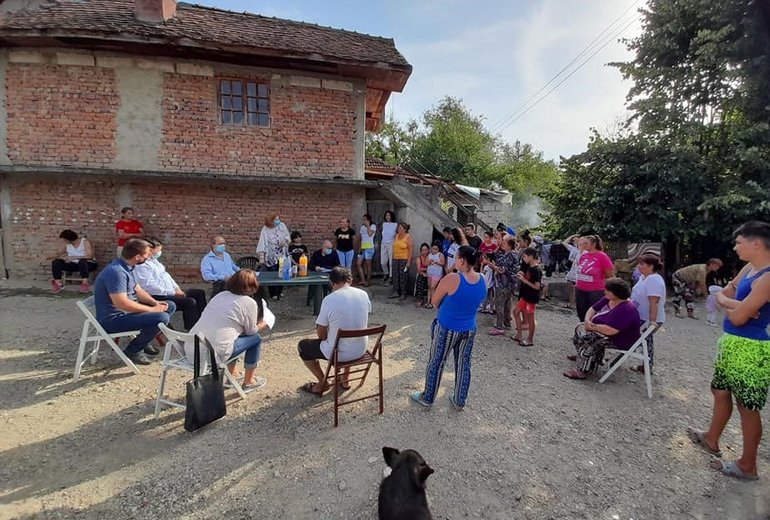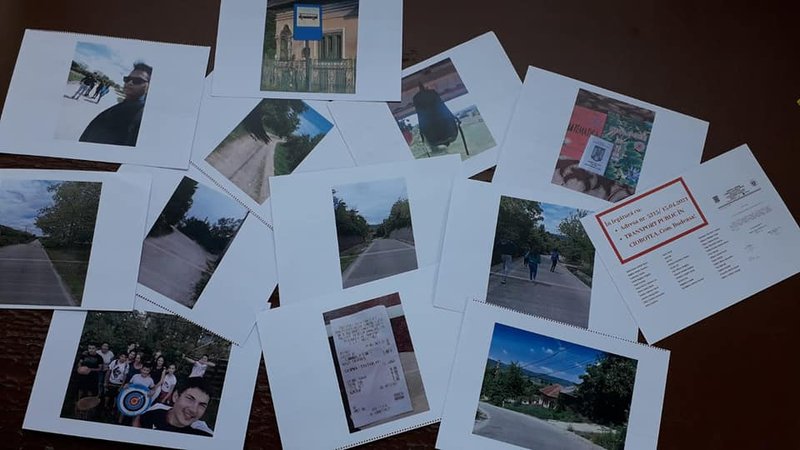Idea Challenge Winners in the spotlight: Organizing for Power

Community Meeting in Ciobotea. (Photo by CeRe)
The CeRe team was an Idea Challenge winner in 2020 and they implemented their idea in 2021 in three different villages in the southwest of Romania. Organizing for Power addressed local communities that are known to lack access to public services and any civic infrastructure, taking on the challenge to engage the unengaged. In their interview they discuss learnings, outcomes, and hopes for the future.
In which communities did you implement your project?
For our project Organizing for Power, we worked in three villages in Romania: Ciobotea (Arges), Izvoru (Giurgiu), and Latinu (Braila). All three of them are rather isolated and underserved – lacking access to public infrastructure and services. In these three villages, most or at least many of the people are experiencing different forms of poverty. People have no special skills or experience, are mostly disengaged, or suffer from deprivation. We aimed at working with a diverse group of people – men and women. By chance, we ended up working mostly with youth and women in one of the villages and with women in the other two.
What were the local challenges that your project idea tried to overcome?
The local challenges were defined by the locals and continued to be at the heart of our work. The challenges defined were a lack of public transportation to the city, low water pressure, and the absence of a pharmacy. Yet we quickly understood that the underlying issue in all three villages was the disempowerment of the people and their inability to voice this to state institutions.

Results of a community meeting in Izvoru village, where locals decided on solutions such as establishing a pharmacy in the village. (Photo by CeRe)
How did you approach solving those challenges?
“We know that many villages in the county are facing this problem [no public transportation], but we came here to Ciobotea because you were so well organized and worked so hard to convince us to come” – said one County Councilor during a public meeting organized during this project.
This statement shows how unconcerned the state institution representatives are about the issues of the local communities. It also shows how much effort people should take to make their voices heard.
To respond to such challenges, we combined two main approaches: community organizing and advocacy. Community organizing is known to build local engagement and empower the citizens, while advocacy is meant to put public pressure on the relevant state institutions to persuade them to address various issues.
How did you come up with the project idea and what is special about it?
Organizing for Power is our effort to put community organizing and advocacy in the service of underserved rural communities. Our purpose is to increase activism and engagement in order to challenge inequity and injustice among people experiencing poverty or lack of access to basic services.
Another rationale behind our intervention was that in disengaged communities it is much easier for the state institutions to ignore the people and their needs. We believe that by supporting people’s voices we hold the leading authorities accountable.

Workshop "My village" with parents and kids in Latinu. (Photo by CeRe)
What were the highlights and challenges that you encountered?
During the project implementation, we faced some challenges. The first challenge was that the locals distrust their capacity to make their voices heard, leading to apparent apathy. The second one was the negative reaction of the state institution representatives. For example, in one of the villages, the vice mayor put pressure on the women we were working with and discouraged them from being so demanding.
Despite facing these challenges, we still managed some achievements. The first direct positive achievement was the improved living conditions for people in villages. For example, we convinced the water company to increase the water pressure for the villagers and the county council to include Ciobotea in the public transportation system. However, the latter is yet to be voted on by the county council. The second achievement was that we were able to create more awareness among the locals regarding their rights and the power of their voices.

Postcard campaign in Ciobotea for local transportation. (Photo by CeRe)
Any main learnings that you want to share with us from the implementation?
You need a lot of time to create trust between the implementing organization and the people you work with. Trust is the basis for people to fully join the activities and citizens in small rural communities are often exposed to abuse of power exercised by state authorities. Their stakes are simply higher than ours as a civil society organization. As needed, at times we took a more prominent role as advocates for the citizens. Being aware that this can create dependency rather than empowerment, we tried to maintain a balance between “representation” and “self-representation” as much as we could.
Another lesson we take from this experience is that in the most deprived communities we should spend more time on building trust and relationships and that we should offer a safe space for community building. It is only after relationships and trust are built that people might have courage for collective advocacy action.

Group picture of the community manager and the youth participating in the campaign for local transportation in Ciobotea. (Photo by CeRe)
Do you have any follow-up plans for the project?
We are currently continuing to support the community in Ciobotea where we safeguard the advocacy win – the inclusion of Ciobotea in the County Public Transportation plan, which is still pending a vote by the county council. Depending on the availability of resources, we plan to continue developing community organizing projects in rural underserved areas.
What is your hope for the future in light of your experience with Civic Europe?
We hope for a larger timeframe and resources to build up a community organizing and advocacy program for vulnerable communities.